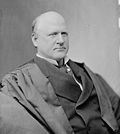Plessy v. Ferguson
Plessy v. Ferguson, 163 U.S. 537 (1896), was a United States Supreme Court case that ruled segregation was legal, as long as equal facilities were provided for both races. The decision was handed down by a vote of 7 to 1. The majority opinion was written by Justice Henry Billings Brown, and the minority opinion was written by Justice John Marshall Harlan.
| Plessy v. Ferguson | |
|---|---|
 | |
| Argued April 13, 1896 Decided May 18, 1896 | |
| Full case name | Homer A. Plessy v. John H. Ferguson |
| Citations | 163 U.S. 537 (more) |
| Prior history | Ex parte Plessy, 11 So. 948 (La. 1892) |
| Subsequent history | None |
| Holding | |
| Louisiana's law requiring segregation is constitutional under the 14th Amendment, as long as both races have "separate but equal" facilities | |
| Court membership | |
| |
| Case opinions | |
| Majority | Brown, joined by Fuller, Field, Gray, Shiras, White, Peckham |
| Dissent | Harlan |
| Brewer took no part in the consideration or decision of the case. | |
| Laws applied | |
| Fourteenth Amendment; 1890 La. Acts 152 | |
Overruled by | |
| Brown v. Board of Education 347 U.S. 483 (1954) (partially overruled) | |
In 1954, Brown v. Board of Education partially overturned the Plessy v. Ferguson ruling.
Background
The State of Louisiana passed a law saying that whites and blacks had to ride in different cars on trains, but required that the train cars be "equal". Homer Plessy, who was one-eighth black (meaning that one of his eight great-grandparents was black) was arrested for riding in a whites-only car. He challenged the Louisiana law, saying it was against the United States Constitution. Plessy argued that the state law which required East Louisiana Railroad to segregate trains had denied him his rights under the Thirteenth and Fourteenth Amendments to the United States Constitution.
The Decision
The Supreme Court, in a 7-1 decision, ruled that the Louisiana law was valid. They said that requiring whites and blacks to ride in separate trains did not harm blacks in any way. Justice John Marshall Harlan was the only justice who thought the law was against the Constitution. He thought segregation made black Americans feel inferior. He said that the Constitution is "color blind" and that the law should not treat any group better than any other group.[1]
Brown and Plessy
In 1954, the United States Supreme Court made it illegal to segregate schools by race. Chief Justice Earl Warren even ruled that "separate facilities are [always] unequal".[2]
However, Brown did not make it illegal to segregate in any other places, aside from schools. Segregation in other places was still legal. This means that Brown overturned part of Plessy v. Ferguson by making school segregation illegal, but it did not overturn the entire law. The entire law wasn't overturned until the Civil Rights Act of 1964.[3][4]
Plessy V. Ferguson Media
An Oklahoma City streetcar terminal's "colored" drinking fountain, 1939
1904 caricature of "White" and "Jim Crow" rail cars by John T. McCutcheon
Related pages
References
- ↑ Medley, Keith Weldon (2003). We As Freeman: Plessy v. Ferguson: The Fight Against Legal Segregation (PDF). Pelican Publishing Company. ISBN 978-1589801202. Archived from the original (PDF) on 2009-03-04. Retrieved 2009-12-05.
- ↑ United States Supreme Court (May 17, 1954). "United States Supreme Court: BROWN v. BOARD OF EDUCATION, (1954), No. 10; Argued: December 9, 1952; Decided: May 17, 1954". FindLaw.com. Retrieved March 2, 2016.
- ↑ Banks, James A., ed. (2012). Encyclopedia of Diversity in Education. SAGE Publications. p. 1665. ISBN 978-1506320335.
- ↑ Hattery, Angela J.; Embrick, David G.; & Smith, Earl (May 1, 2008). Globalization and America: Race, Human Rights, and Inequality. lishersRowman & Littlefield Pub. p. 6. ISBN 978-1461665366.
{{cite book}}: CS1 maint: multiple names: authors list (link)



